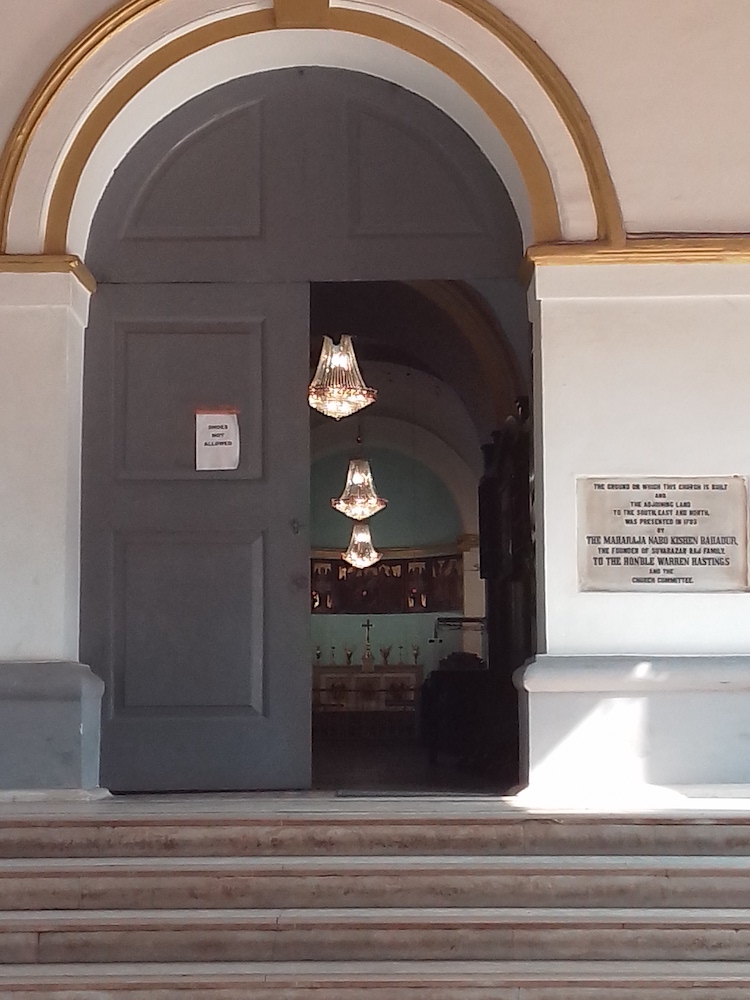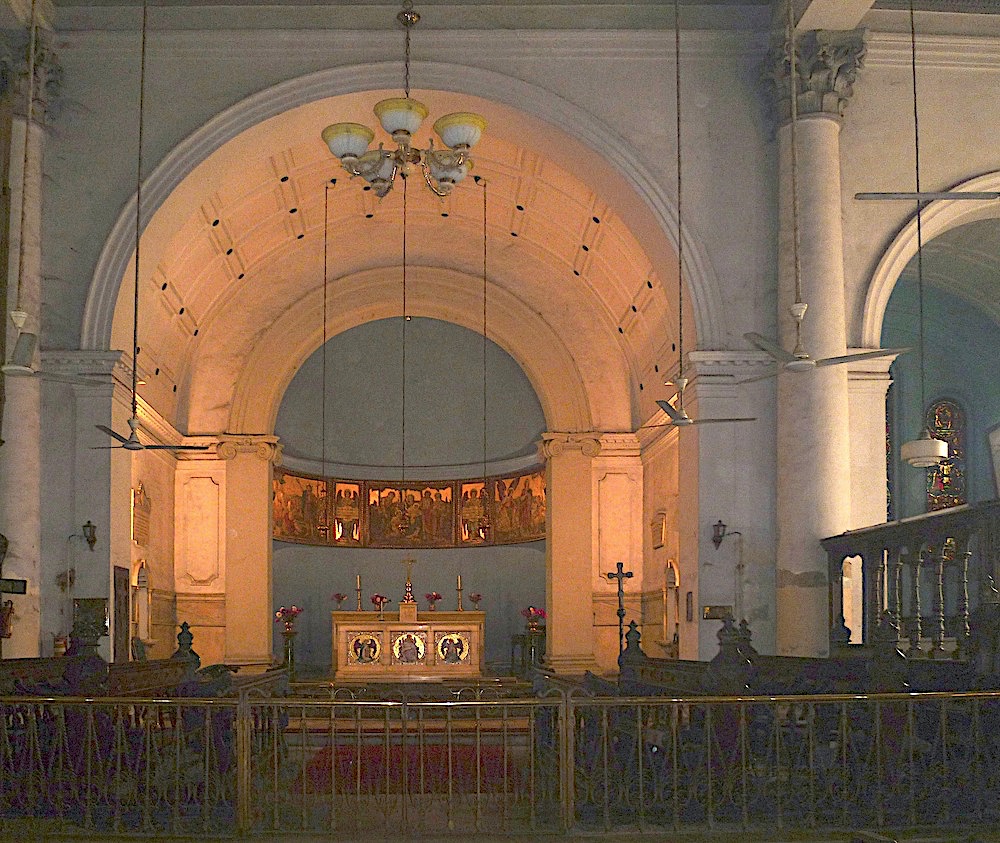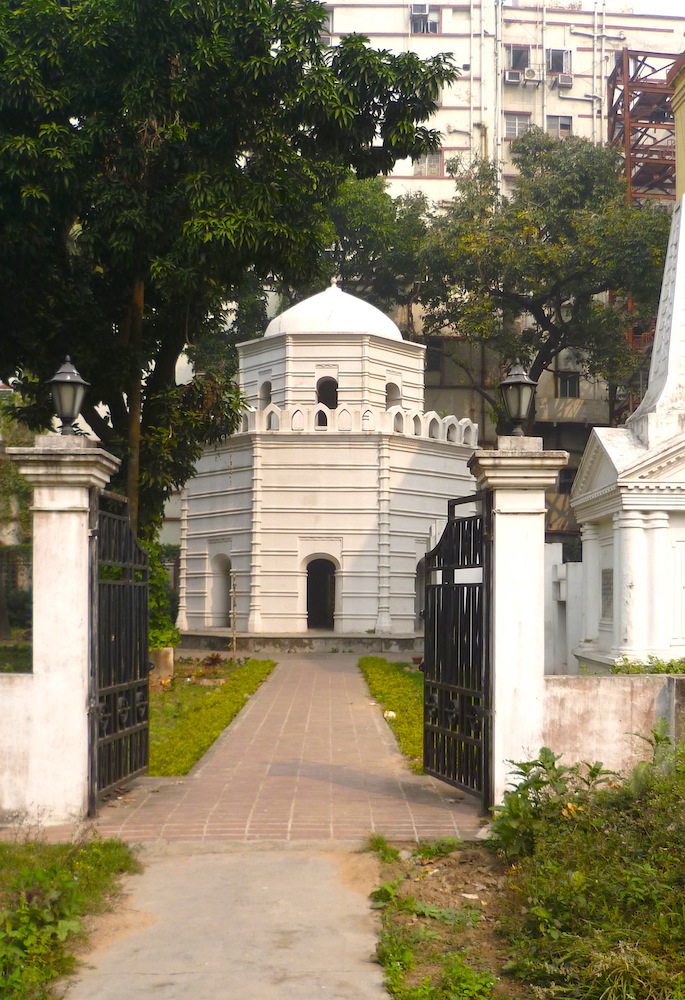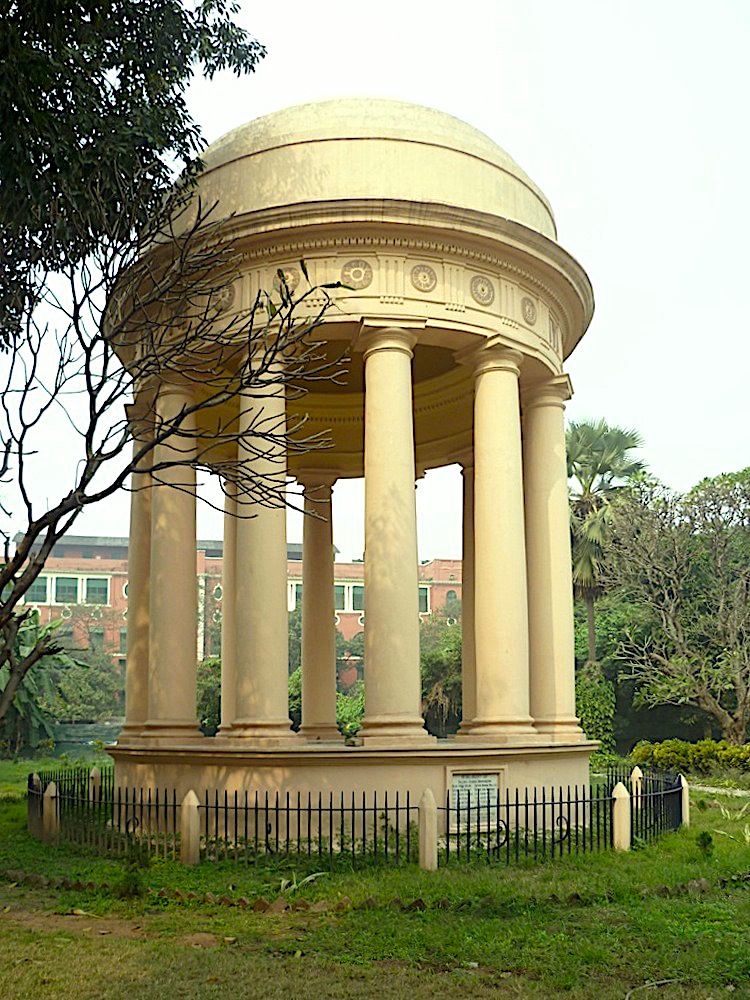Photographs in 2014 by the author, except one (where specified) added in 2021 by Oindrila Gosh. [You may use these images without prior permission for any scholarly or educational purpose as long as you (1) credit the photographer and (2) link your document to this URL or credit the Victorian Web in a print one. Click on the images to enlarge them.]
The Church Building

St John's Church, India. Architect: Lieutenant James Agg of the Bengal Engineers (Charles Wyatt, of the Wyatt dynasty of architects, was another Bengal Engineer who was active in Kolkata). 1784-87. Material: local Chunar stone and bricks; St John's is familiarly referred to in Kolkata as "the stone church." It is deeply imbued with the history of the British in India. Just off Kiran Shankar Roy Road, Kolkata, it was built on a pre-existing graveyard, so that "the foundations were laid among the mouldering remains of scores upon scores of those who had died during the ninety years of the English occupation" (Blechynden 138). Bishop Heber, best known for his hymns, ministered from here, but its particular resonance for students of literature may be its connection with the Thackeray family.


Left: The porticoed verandah along the south side of the church. Right: Entrance to the church, at the west end, taken at a later date by Oindrila Gosh.>
As for the church building itself, Lieutenant Agg's father had been a stonemason in Gloucestershire. He came out to India in 1777, succeeded in doing well for himself, and returned home (Davies 58). His general model, as so often in those days, was James Gibbs's St Martin's-in-the-Fields by Trafalgar Square in London, but worries about local conditions, the marshy ground, and cost all contributed to a different outcome from the one Agg had intended: "The end result is extraordinary," says Davies, citing the amateurish steeple with its "dumpy and compressed" appearance (59). There were later changes too, such as the addition of the porticoed verandahs to the exterior, to allow more shade, and the removal of galleries in the interior — this last, in 1901.
The Interior: A Witness to History


Left: An interior view of St John's, showing the altarpiece by Johannes Zoffany — a controversial painting of the Last Supper, for which prominent Calcutta residents modelled. Right: The stained glass windows, with the crucifixion in the middle, the Ascension above it, the Baptism of Christ to its right, and so on.
Even Bishop Heber, who ministered here as second bishop of Calcutta when St John's served as the city's cathedral church, found his house of worship rather quirky. He too particularly picked out the spire, as being "short and clumsy," adding that the "whole composition, indeed, of the Church, is full of architectural blunders." Still, on the whole, he was well pleased, writing in his journal, "it is, in other respects, handsome. The inside is elegant, paved with marble, and furnished with very large and handsome glass chandeliers ... with a light pulpit, with chairs on one side of the chancel for the Governor-General and his family, and on the other for the Bishop and Archdeacon" (qtd. in Firminger 133).

The first to explore Thackeray's Indian background was Sir William Hunter, who explains, "The first Thackeray in India went as a covenanted civilian in 1766." The family thrived and in time came to constitute "one of those powerful and compact, but now almost extinct, family corporations which did so much to build up British rule in the East" (Hunter 64). Both Thackeray's grandparents and parents were married in this church's "handsome" interior: the vestry book records his grandfather William Makepeace Thackeray's marriage to Amelia Richmond Webb on 31 January 1776 (Hunter 98), and his father Richmond's was entered in the register there on 13 October 1811 (Hunter 169). Richmond died when his son was only four years old, and, like so many children at this time, the boy was quickly dispatched to the home country: the scene of his departure in 1817, with his cousin Richmond, was never forgotten by the novelist, who recreated in his Roundabout Papers "a ghaut or river-stair at Calcutta; and a day when down those steps, to a boat which was in waiting, came two children whose mothers remained on shore" (244).
Historic Memorials, Inside and Out



Left to right: (a) Wall monument to William Twining. (b) The Charnock Mausoleum. (c) The Rohilla Memorial.
The Thackerays were not unique; they were representative. St John's tells so much about the early days of the whole British community in India. Inside the church, William Twining's memorial, with its easily recognisable Asclepian motif, is one of the many that contribute to its sense of the past. Dr. Twining, a medical veteran of the Peninsular War and Waterloo, came to Calcutta in 1823 as surgeon to Commander-in-Chief Sir Edward Paget, and joined the Bengal Medical Department a year later. His practice is said to have been huge, though he was still in his early forties when he died trying to help someone who had been thrown from a carriage (see Cotton, Calcutta Old and New, 14; "The Indian Medical Service," 166). He is known for his early study of cholera: despite some of the scary "cures" he proposed, discussed elsewhere on this website, he did cast doubt on the theory that it was contagious, suggesting that improving drainage and general standards of living could prevent the disease spreading (see Twining 290). Copies of his book appear at the foot of the memorial tablet. For a selection of larger and often very beautiful memorials in the church interior, see "Related Material" below.


The Black Hole monument, with a close-up of the base.
The most important of several major historical features of the graveyard is the Charnock Mausoleum, probably erected in 1695 and thus the oldest piece of British masonry in the city (see Firminger 135-36). This is the last resting place of Job Charnock (1630-1692), generally credited with having been the founder of Calcutta: here he "sleeps undisturbed amid the dust and din of the town he called into existence" (Cotton, Calcutta Old and New, 14). Other impressive monuments are the curiously carved rotunda of the Rohilla Memorial (1794), commemorating those East India Company men who died fighting the Rohillas in Northern India in the early 1770s (see Firminger 139), and the obeslisk-style monument to those who died in the notorious and much-disputed Black Hole of Calcutta episode of 1756. According to the still distinct inscription on the base of the monument itself, which is shown to the right here, this was put up by Lord Curzon, unveiled in 1902, and moved here in 1940.
St John's was not built as a cathedral, and in 1847 ceded that function to the purpose-built St Paul's (where Thackeray's much loved cousin Richmond is memorialised, with an inscription composed by the novelist himself). But, for all its "architectural blunders" and alterations, the old "stone church" is held in much esteem. Full of interest and historical resonances, it has rightly been called "[t]he most firmly established, the most pukka, the most dignified, the most pedigreed, and the most Calcuttan of Calcutta's churches" (Bach 606).
Related Material
- William Makepeace Thackeray: A Brief Biography
- Tomb monument to Lady Charlotte Canning, by Sir George Gilbert Scott and John Burnie Philip
- Monument to Alexander Colvin, by Sir Richard Westmacott
- Monument to George Cruttenden, by Sir Richard Westmacott
- Monument to Michael Cheese, by Sir Richard Westmacott
- Monument to Walter Nisbet, by Sir Richard Westmacott
- Monument to Lt. Col. John Ludlow, by William Pistell
- Monument to Lt. Col. James Achilles Kirkpatrick, by John Bacon the Younger
- St Paul's Cathedral, Kolkata, by William Nair Forbes
- Cholera (this describes some of Twining's not-to-be-tried remedies!)
Bibliography
Bach, Brian Paul. Calcutta's Edifice: The Buildings of a Great City. Kolkata: Rupa, 2006.
Blechynden, Kathleen. Calcutta, Past and Present. London: W. Thacker & Co., 1905. Internet Archive. Web. 27 March 2014.
Cotton, H. E. A. Calcutta Old and New: A Historical and Descriptive Handbook to the City. Calcutta: W. Newman & Co., 1907. Internet Archive. Web. 27 March 2014.
_____. "The Indian Medical Service" (review). Bengal Past and Present (Journal of the Calcutta Historical Society). Vol. 41, 81-82 (Jan.-June 1931): 165-173.
Davies, Philip. Splendours of the Raj: British Architecture in India, 1160-1947. London: Penguin, 1987.
Firminger, Rev. Walter K. Thacker's Guide to Calcutta. Calcutta: Thacker, Spink & Co., 1906. Internet Archive. Web. 27 March 2014.
Morris, Jan, with Simon Winchester. Stones of Empire: The Buildings of the Raj. Oxford: Oxford University Press, 2005.
Thackeray, William Makepeace. "Letts's Diary." Roundabout papers. New York: Harper & Brothers, 1863: 234-46. Internet Archive. Web. 27 March 2014.
Last modified 28 March 2014